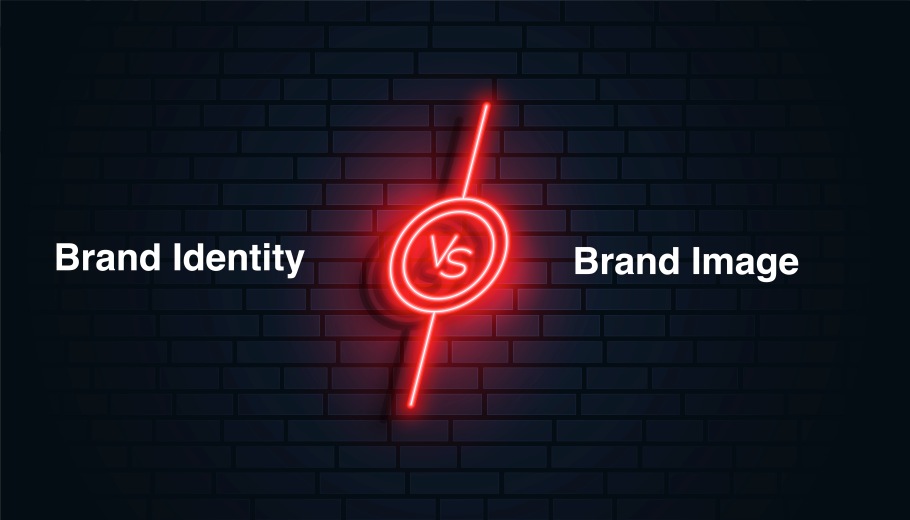Brand identity and brand image are two essential components of marketing that involve the overall perception of a brand’s image in the minds of consumers. While they are related concepts, important differences must be considered when building and managing a successful branding strategy.
This blog post will explore the key similarities and differences between brand image and identity.
What is Brand Identity?
A brand’s visual identity comprises various aspects that identify it to the public, such as color schemes, designs, and logos. These attributes are essential in creating customer recognition and distinction for your company. Suppose a potential customer finds your logo or color scheme familiar. In that case, they are more likely to remember and trust your brand when selecting a product or service.
The following are the elements of brand identity.
Logo
The logo visually represents a company’s image and identity throughout. A good logo is simple, recognizable, and memorable. Logos should evoke an emotional response from viewers and convey who the company is and what its brand stands for. It usually consists of symbols, colors, and text.
Brand Colors
Brand colors are an important part of a company’s identity. Colors psychologically affect consumers and can help create an emotional connection with them through brand associations. They should be used consistently across all branding materials to create familiarity and recognition of the brand owner.
Tone of Voice
The tone of brand voice should be consistent across all communications and represents the company’s values, beliefs, and position in the marketplace. It should reflect the brand’s personality and create an emotional connection with consumers. The tone of voice should be tailored to target audiences and adapted as needed.
Do you want your brand to stand out and create a lasting impact?
Contact Growth Hackers
How to Improve Your Brand Identity
A strong brand identity can help differentiate a company from its competitors and create a lasting impression on customers. Here are some tips for improving your company’s brand identity.
- Define Your Brand Values: The first step to creating an effective brand identity is to define the core values that will guide all marketing activities.
- Establish Your Brand Personality: Your brand identity should convey certain personality traits that make it stand out. This could include a fun, approachable tone of voice or an upbeat graphics style.
- Develop Your Brand Story: Every brand should have a compelling story behind it that customers can relate to and be inspired by. Take the time to research what makes your company and product unique, and create content that highlights this information.
- Define Your Visual Identity: Your visual identity is one of the most important components of your brand identity and includes things like logos, color palettes, typography, imagery, etc.
What is Brand Image?
Brand image is the perception a consumer has of a brand. As brand image represents the collective impressions of a company, it encompasses more than just its visual identity. It is formed and shaped by a company’s marketing activities, promotional campaigns, customer experience, and public relations efforts. Brand image can be positive or negative and affects how customers perceive a brand image representing a company and its products or services.
The elements of the brand image include.
Promise
The promise of a brand is what customers expect when they purchase a product or service. It should be honest and consistent with the company’s mission and values. For example, if a company promises excellent customer service, it must deliver on that promise to maintain customer trust and loyalty. A solid brand image should assure customers that the promise of the company will be fulfilled.
Positioning
Positioning is how a company positions itself in the marketplace relative to its competitors. It helps establish the brand identity and image and can create an emotional bond with customers. Positioning should be unique and authentic, clearly communicating what differentiates it from competitors.
Perception
Perception is a customer’s mental image of a brand and can significantly affect their buying decisions. Companies must create a positive perception of their brand by communicating, delivering on promises, and providing excellent customer service. This helps build trust and loyalty amongst customers.
How to Improve Your Brand Image
A strong brand image can help differentiate a company from its competitors and create a lasting impression on customers. Here are some tips for improving your company’s brand image.
- Engage in Social Media Marketing: Social media is one of the most powerful tools for creating an engaging brand image. Use social media to interact with your customers, respond to their queries, share relevant content, and build relationships.
- Create Compelling Content: Content creation is key to establishing a positive brand image. Take the time to research customer needs and write compelling copy that speaks directly to them. Additionally, incorporate visuals such as videos, infographics, or illustrations into your content to capture attention and draw readers in.
- Focus on Customer Service: Customer service is important in building a positive brand image. Respond promptly to any customer inquiries and provide helpful advice or solutions. This will show your customers that you value their opinions and take their feedback seriously.
Key Similarities Between Brand Identity and Brand Image
Now that we’ve explored the components of the brand image let’s look at how it relates to brand identity.
Both are Multi-layered Concepts
Brand identity and brand image are complex concepts comprising multiple layers. Brand identity is, by definition, made up of the core values, mission, vision, and story of a company or product’s brand. While the brand image consists of how consumers perceive the organization or product based on its appearance, messaging, and media use.
Both Aim to Create an Impact on Consumers
The primary goal of brand identity and brand image is to create an impact on consumers. A strong brand identity helps a company or product stand out from its competitors and make a memorable impression on potential and existing customers. Similarly, the brand image works with the company’s mission, values, and story to create an emotional connection with the consumer.
Require Constant Maintenance
Both brand identity and brand image require constant maintenance and updating. As the company or product grows and evolves, so must its core values, mission statement, and story. Brand image refers to identity that requires consistent tweaking based on customer feedback, industry trends, and marketing campaigns to stay relevant. Companies must maintain their brand identity while attaining new customers through creative messaging and unique appearance.
Require Strategic Planning and Execution
Successful brand identity and good brand image result from strategic planning and execution. Companies must craft a brand image encompassing a unique story, mission statement, and values while engaging in marketing campaigns that convey those same messages. Effective branding requires careful consideration of the customer’s needs and wants and a comprehensive understanding of the industry to create an impactful message that resonates with consumers.
Through careful planning and execution, companies can craft a unique brand identity and image that give them an edge over their competitors. With a strategic approach to branding, companies can build customer trust and loyalty while creating an emotional connection through their messaging and visuals.
Understanding the difference and similarities between brand identity and brand image is also essential for developing a successful branding strategy.
Make sure to develop a strong brand identity and a compelling brand image today!
Key Differences Between Brand Identity and Brand Image
Just as there are similarities between brand image and identity, there are also some key differences.
Brand Identity is an Internal Process
Brand identity is an internal process that begins with the company or product creating a mission statement, core values, and story for its negative brand image. It involves analyzing consumer feedback and industry trends, and the customer wants to craft a unique brand identity. An in-house marketing team usually does this process to create alignment between the company’s internal values and its outward public image. It also differentiates a brand from its competitors and communicates key messages that help establish customer relationships.
Brand Image is an External Process
On the other hand, brand image involves an outside perspective looking into your brand and products from a consumer’s point of view. It is determined through customer feedback, market research, surveys, and even online reviews. This can clearly show how people perceive your product or service and what needs to be improved for better customer interaction and retention. A successful brand image resonates with consumers and shows a good understanding of their needs and how your product can meet them. It requires ongoing research and monitoring to stay relevant and up-to-date with industry trends.
Different Goals
The goals of brand identity and image are also different. Brand identity is focused on how a company wants to be perceived by its customers, while brand image is focused on how customers perceive the company. Brand identity involves creating an ideal impression of the brand through elements like logo, design, and messaging. It is also about building trust and loyalty among customers. In contrast, the brand image emphasizes understanding customer perceptions and expectations to improve, build upon, and maintain that trust.
Closing Thoughts About Brand Identity vs Brand Image
Brand identity and image are both necessary components of a successful business. By understanding their differences, companies can craft an effective brand strategy that resonates with their target audience and communicates their values meaningfully. Businesses can create powerful brands that stand out through research, customer feedback, and market analysis.
It’s all about telling a consistent story that resonates with customers. With the right identity and image, companies can create meaningful relationships with their audience that will last years.
So, whether you’re a start-up or an established business, understanding the similarities and differences between brand identity and the image is essential for creating an impactful message that will stand out in a crowded market. With the right approach, you can create customer loyalty and trust that will help elevate your business to success.
Growth Hackers is a full-service branding agency helping businesses from all over the world grow. There is no fluff with Growth Hackers. We help entrepreneurs and business owners with strong brand identity services, create a positive brand image, increase their productivity, generate qualified leads, optimize their conversion rate, gather and analyze data analytics, acquire and retain users and increase sales. We go further than brand awareness and exposure. We make sure that the strategies we implement move the needle so your business grow, strive and succeed. If you too want your business to reach new heights, contact Growth Hackers today so we can discuss about your brand and create a custom growth plan for you. You’re just one click away to skyrocket your business.








